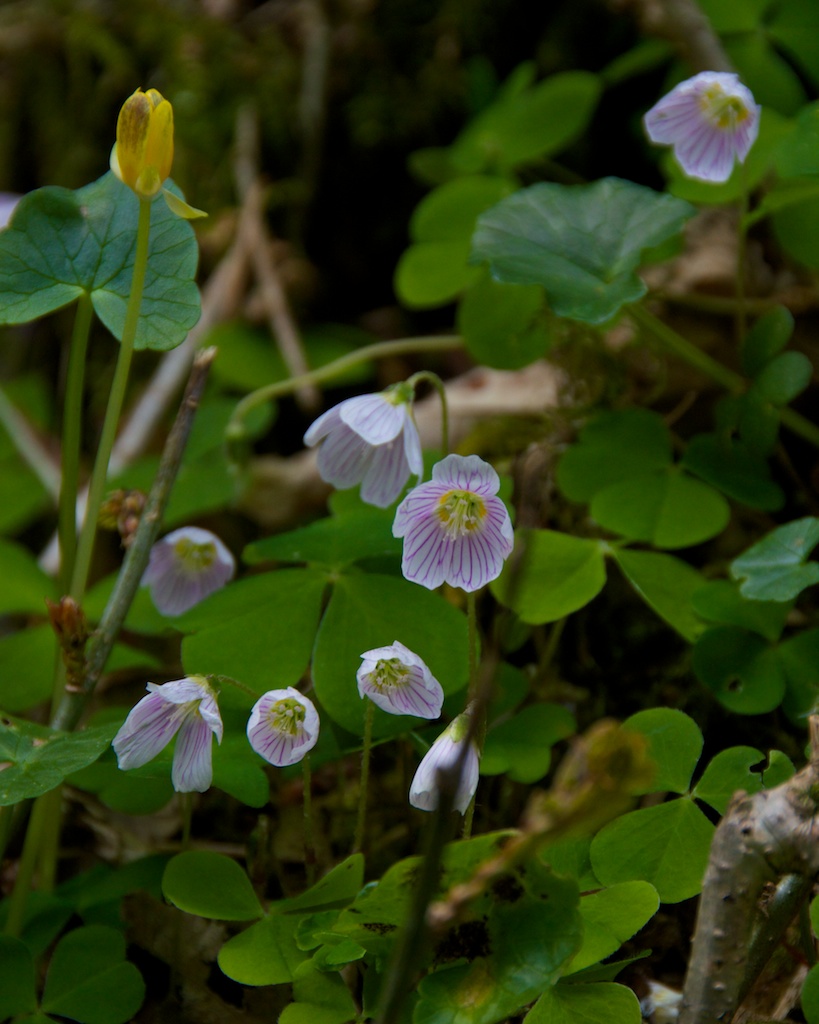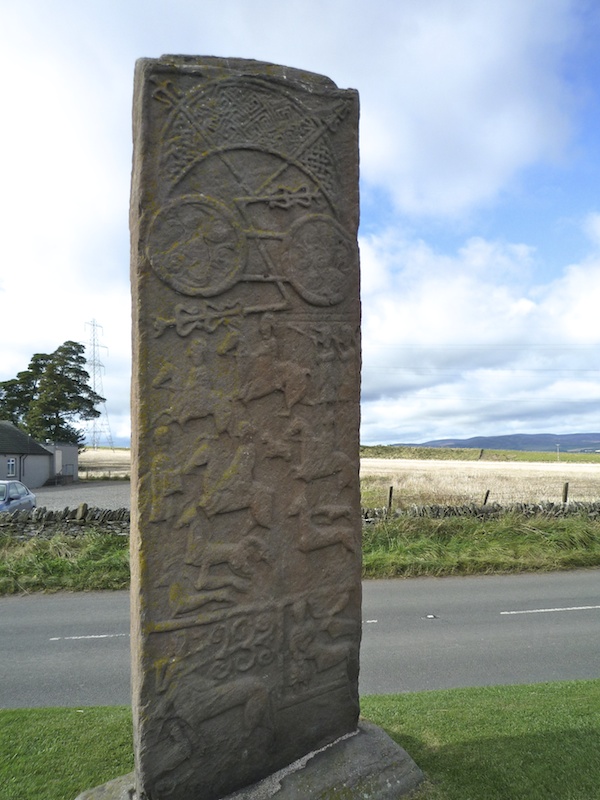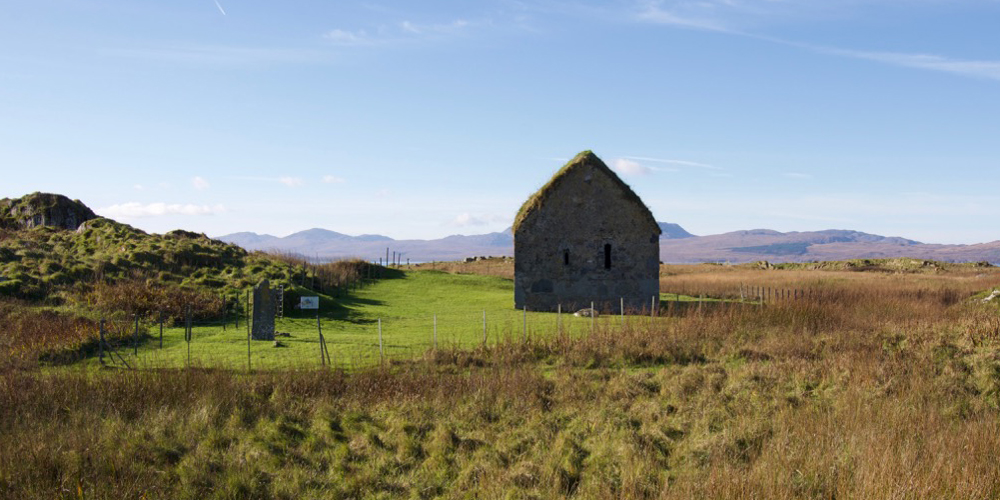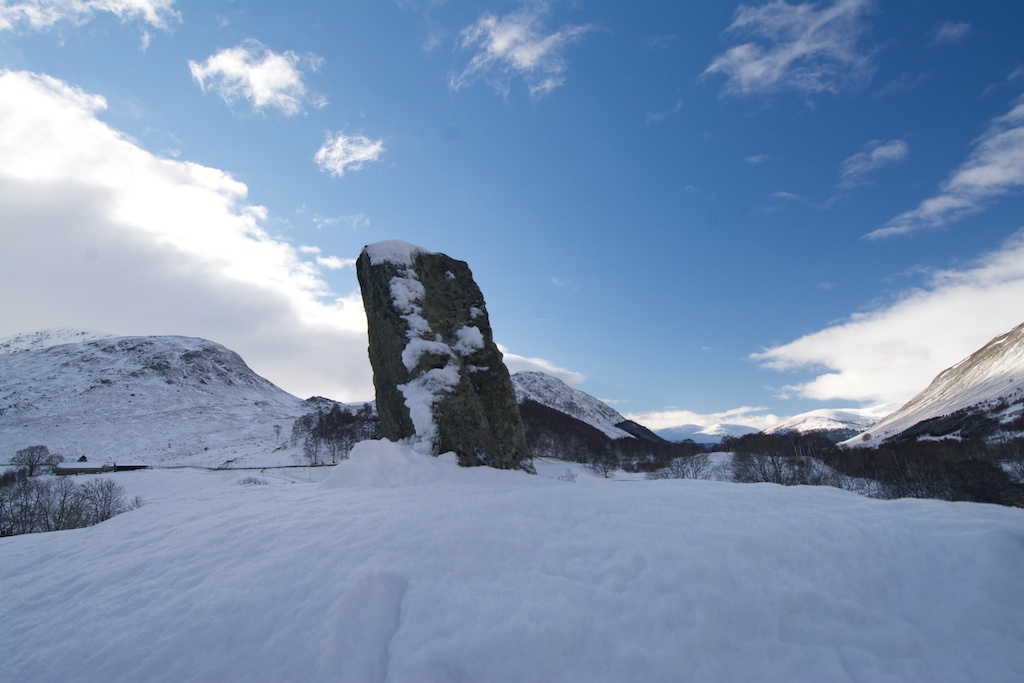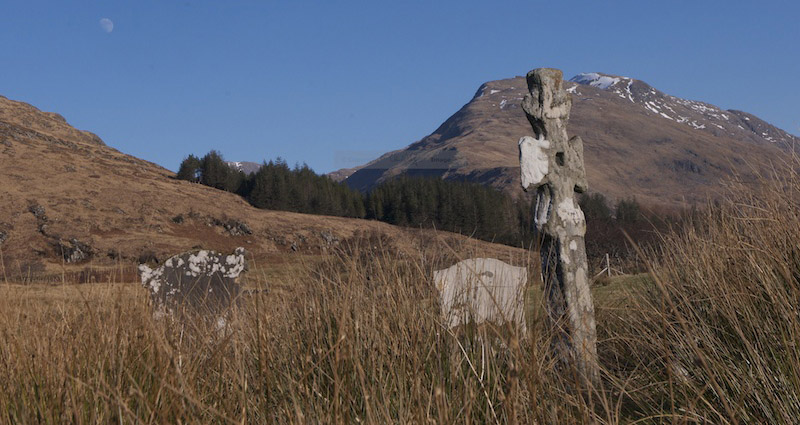
The mystery of the Kilchoan Cross
 Of all the ancient sites and monuments I’ve featured on The Hazel Tree, perhaps none has a more remote or spectacular setting than the Kilchoan Cross at Inverie.
Of all the ancient sites and monuments I’ve featured on The Hazel Tree, perhaps none has a more remote or spectacular setting than the Kilchoan Cross at Inverie.
Inverie is the only ‘village’ on Knoydart, a mountainous peninsula in north-west Scotland. To get there, you have to travel by ferry or on foot. (Well, I guess you could also be helicoptered in!)
A short distance to the south-east of Inverie is an old graveyard, now very much overgrown, close to where a small church once stood. Above the tall stems of reeds and grasses a stone cross rears its ancient head.
The nearby church was dedicated to St Comgan, a prince of Leinster who left Ireland in 717 AD in order to spread the word of the gospels. In fact, the name ‘Kilchoan’ comes from the Gaelic ‘cille’, meaning ‘church’, and Comgan’s own name in the suffix ‘Choan’. St Comgan was only one of many such missionaries: the best known is St Columba, who founded the Abbey on Iona.
Nothing now remains of the church, but some grave slabs nearby, curiously kite-shaped and carved with a simple cross, suggest a link with Dál Riata, the ancient Gaelic kingdom that encompassed much of western Scotland in the 6th and 7th centuries AD. These slabs are partly hidden in the undergrowth.
What strikes you first about the Kilchoan Cross is not its age, although its features are certainly weather-worn and the carvings are partly obscured by lichen. It’s the small, square-shaped hole in the middle. For me – and, more importantly, for better informed historians – this suggests an origin that has little to do with Christianity. Somehow, it’s the look of it that tells you.
 Carvings that have been identified on the cross head include a galley with its sail furled, which you may be able to make out in the photo (I think it is in the centre, above the hole). On the pillar of the cross a sword is carved, and the single-handed design of this weapon is what dates the cross – or at least, its carvings – to the 15th century. Unlike many monuments of the same era, there are no traces of an inter-connecting ring between the four arms, like a typical Celtic cross. And there’s a short projection or flange on the upper ‘arm’: what’s this for? Was it made to avoid cutting off the top of the galley?
Carvings that have been identified on the cross head include a galley with its sail furled, which you may be able to make out in the photo (I think it is in the centre, above the hole). On the pillar of the cross a sword is carved, and the single-handed design of this weapon is what dates the cross – or at least, its carvings – to the 15th century. Unlike many monuments of the same era, there are no traces of an inter-connecting ring between the four arms, like a typical Celtic cross. And there’s a short projection or flange on the upper ‘arm’: what’s this for? Was it made to avoid cutting off the top of the galley?
On the back of the cross is a carving of a man on horseback, and – in the opinion of some historians – a depiction of Daniel in the lions’ den. Some of the sources I’m referring to are quite old, and I am sure that this scene would have been much more evident at the time of inspection. You’d need a sharp eye and a lively imagination to make it out now.
 But somehow my eye is drawn back to the intriguing central hole; it’s almost as if the cross has an ‘eye’ of its own. The historian Denis Rixson considers that pierced stones held an important place in pre-Christian rituals, when groups of people would make a journey around various important sites, maybe leaving tokens in the way that we still drop pennies in a wishing well, and sometimes putting their hand (or even their head) inside a custom-made hole or hollow. In a couple of cases, namely a pierced stone at Kilmartin in Argyll and another at Stenness on Orkney, a betrothed couple would link hands through the hole in order to be pronounced man and wife. There’s no such story attached to Kilchoan, and its carvings at least date it to a later time; but that doesn’t necessarily exclude it.
But somehow my eye is drawn back to the intriguing central hole; it’s almost as if the cross has an ‘eye’ of its own. The historian Denis Rixson considers that pierced stones held an important place in pre-Christian rituals, when groups of people would make a journey around various important sites, maybe leaving tokens in the way that we still drop pennies in a wishing well, and sometimes putting their hand (or even their head) inside a custom-made hole or hollow. In a couple of cases, namely a pierced stone at Kilmartin in Argyll and another at Stenness on Orkney, a betrothed couple would link hands through the hole in order to be pronounced man and wife. There’s no such story attached to Kilchoan, and its carvings at least date it to a later time; but that doesn’t necessarily exclude it.
I guess if you were Indiana Jones, you’d wait for a shaft of sunlight to beam through the hole at midsummer sunrise, which would guide you to a long-lost relic – or a nest of vipers! Taking a more practical line, perhaps something like a wooden pole might have slotted through there, for some unimaginable ritual purpose or even to ease its transport.
What if the stone is, in fact, a much older monument that has been modified with the passing of time, first with the central hole and then with Christian carvings – even the cross-head shaping – to satisfy the evolving beliefs of the local people?
However much you stare at the Kilchoan Cross, it’s not going to reveal its secrets. All we can do is speculate. And that is ‘history’ at its best!
3rd March 2014 – Postscript to original article
The Kilchoan Estate has kindly shown me photographs of three pages from a document which I imagine to be a report by an archaeological or historical society.
Dated 13th March 1911, the report states that, at one time, the shaft of the cross was buried in the ground to a depth that left only the head still showing. The writer, who had seen the cross in this state, reports: “The stone cross mentioned in the foregoing letter is still standing in the cemetery of Kilchoan. Although at present only 2 feet 10 inches above the ground, the men of the place assured me that they had, even quite recently, seen 3 feet and more under the ground. The cross is 4 inches thick, and measures 2 feet across the arms. Through the centre is a strange hole 3 inches square, around which there is interlacing of a not uncommon pattern. At the head of the cross on the one side is a horse and rider, and on the other side a galley. I am glad to say that arrangements are being made to raise this fine cross to its original height. Situated as it is on a little hillock in the centre of the churchyard, it will then form a really imposing monument.”
My thanks to the Kilchoan Estate for this information.
Sources:
- ‘Knoydart – A History’ by Denix Rixson, pub. Birlinn Ltd.
- RCAHMS Canmore
Footnote: The Royal Commission on the Ancient and Historical Monuments of Scotland considers that the cross originates from the mid 16th century or later; Denis Rixson believes it is of an earlier date. The RCAHMS also states that the cross has been moved from its original site, into the centre of the graveyard. Burials were still being made in the graveyard until the late 19th century.
All photos copyright © Colin Woolf
Take a look at four more wonderful examples of Celtic-style crosses:
